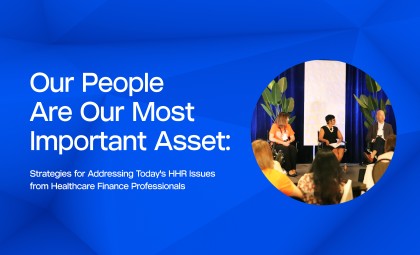Our People Are Our Most Important Asset: Strategies for Addressing Today’s HHR Issues from Healthcare Finance Professionals

HIROC was delighted to support and attend the recent National Healthcare Finance Conference brought to the community by Spark Conferences. The event brought together finance professionals from across our healthcare sector to explore the trends and challenges many organizations face today.
The two-day event was hosted by Dee Perera, a Senior Executive who supported many healthcare systems, including Sinai Health, Woodstock, Joseph Brant, and Brant Community Healthcare System. Perera created a space for delegates to share their unique perspectives and learn from the many impactful sessions.
Check out our LinkedIn page to read about some of the takeaways from the sessions.
One notable session featured an engaging panel discussion on today’s health human resources issues from a healthcare finance standpoint, such as addressing staffing shortages, building stronger working relationships, and adapting to the future of work in healthcare.
Nathalie Cadieux, Executive Vice President and Chief Financial Officer at The Ottawa Hospital, and Young Lee, Vice President of Finance and Chief Financial Officer at The Hospital for Sick Children (SickKids), were on stage to offer the following key insights and strategies to the audience.
Developing the Next Generation of Healthcare Finance Professionals
Having a robust mentorship program was highlighted by the panel as an effective way of showcasing healthcare in the best light by centering on what leaders could provide for new recruits.
“We have a strong potential to be a brand master,” added Perera. “If you, as a leader, have a good brand, people will look at you and say ‘yes, I want to join that team.’”
For her approach to spotlighting mentorship, Cadieux advocates for something more personal, less formal – a working relationship where she can focus on discussing aspirations with her staff and use her own experience to help them achieve their career goals.
To attract and retain talent, Lee recommends leaders reaffirm their commitment to determining the overall value a new hire can bring to the team. He said leaders should approach hiring and mentorship with an open mind and be open to change.
“What’s really important when approaching the newer generation is an overt conversation on what they’re expecting from their experience,” added Lee.
Cadieux has even worked with her HR department to create a value proposition document to bring into interviews showcasing why her organization stands out and what it can provide to people who join their team.
“In the interview, I try and focus on the meaningful things the hospital does,” adds Cadieux. “When I say it’s about giving back to the community, you see the direct impact of all the work and efforts you do on a daily basis.”
They both also touched upon managing workloads effectively. Lee suggests leaders look critically at the tasks they receive and consider reevaluating their priority by asking themselves “When was the last time I made a decision based on that before?” Cadieux also emphasized this point, adding that more than ever, leaders need to consider balancing their bandwidth to manage their teams.
Staying Connected Builds Strong Working Relationships
From the perspective of healthcare finance teams, staying connected at work is more than just a matter of convenience to accomplish tasks – it’s a vital investment in staff retention and ultimately, the healthcare system itself.
“The biggest challenge recently has been maintaining relationships,” said Lee. “You can see that in terms of forming those relationships for someone that’s newer. It’s also challenging for those who have worked together for a long time to sustain those relationships.”
According to Lee, with some potential recruits wanting more autonomy and flexibility in their roles, organizations should continue to embrace hybrid work models as an ongoing option and determine where and how it makes sense for both the individual staff member, their team, and the organization as a whole. He points to his own positive experience working with remote teams, and how that action partly led to a larger talent base at SickKids.
Cadieux underscored the importance of flexibility and remaining agile as an organization. With the talent pool sporting recruits from a younger generation, adapting to how they operate and communicate is essential for building stronger working relationships.
However, Cadieux also recommended leaders still meet with their staff in-person as much as possible through scheduled meetings or planned social events. She emphasized how face-to-face meetings help new staff stay connected to the organization’s purpose and to the team.
“One of the lessons I learned during the pandemic was that the human connection was lost through talking to people online,” added Cadieux. “Our people are our most important asset. Without our workers, we can’t take care of patients.”
If you have any questions about this article or if you’re interested in sharing a safety story from your organization with HIROC, please connect with us at [email protected].
By Marc Aiello, Communications and Market Specialist, HIROC